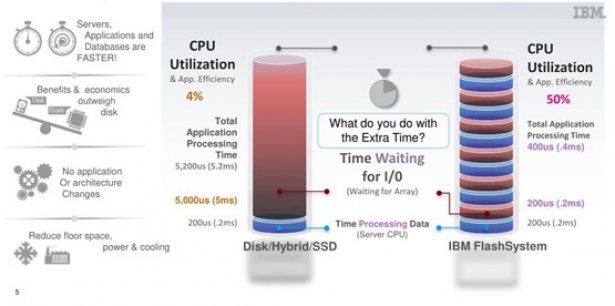
IBM Power and IBM FlashSystem – a technological dream team
Progressive digitization brings a lot of new things with it: new technologies, new market opportunities, new business models, new jobs, new ways of working and much more. Above all, however, it also brings with it an ever-increasing amount of data that must be collected, transmitted, processed and stored.
According to a study by Splunk, business and IT executives from around the world expect the amount of data alone to increase almost fivefold by 2025*. Such tremendous growth places high demands on data centers and therefore on the storage devices located there.
Storage requirements vary depending on the type and use of the stored data. Taking response times, scalability and costs into account, we will show you why an IBM FlashSystem makes sense, especially with IBM Power.
Initial situation
Flash-based solid state disks (SSD) have been available for more than 20 years. Due to their immense costs, only a few companies were using them at that time. Especially the mechanical robustness and the high performance of the SSD have led to the fact that today they are also used for the broad market, especially in notebooks and in powerful storage systems.
For several years now, the operating system of the IBM i has been able to be used much more efficiently than with conventional mechanical disks thanks to the SSD disks. The IBM FlashSystems give the IBM i another massive performance boost and the CPU can be used more efficiently. We summarize the advantages for you.

Response time
Typical applications that require a high access speed and thus a fast response time are databases or transaction applications. Also classical analytical applications such as CRM, ERP and SCM require short response times.
Conventional disks typically have a response time of about 3-5 ms per I/O; solid state disks (SSD) have a response time of about 1-3 ms. In contrast, real Flash Core Modules (FCM) shine with a response time of < 0.25 ms, which corresponds to an enormous increase in performance.
Thanks to ever faster CPUs, data processing is much faster. The IBM graph below shows a comparison of the average response time between conventional mechanical disks at 5 ms and IBM Flash Core modules at typically 0.2 ms.

In the example in Figure 1, the process time for processing a request with conventional (SAS) disks is 5.2 ms, with a CPU utilization of only 4%. With an IBM FlashSystem the processing time is 0.4 ms and the CPU utilization is 50%.
The lower utilization of the CPU with 4% means that the CPU has to wait a long time for the data during this period. With an IBM FlashSystem, more data is delivered to the CPU in a very short time and the CPU gets the possibility to process more transactions in the same time span. This makes better use of the CPU, which means that fewer CPU’s can be used for the same workload, which also saves software license costs.
Scalability
The amount of data to be handled by data centers will grow rapidly in the future, and will continue to do so until the available storage space is full. So what happens when storage capacity is expanded? Does the available computing power have to grow linearly?
We recommend that you consider whether the larger data volume necessarily means that retrieval must be faster or whether a larger number of retrievals must be possible in parallel. With IBM FlashSystems, it is possible to let the two components grow relatively independently of each other.
External storage, such as flash storage on IBM i, enables higher performance by providing storage capacity more flexibly to each server, exactly where it is needed. If the storage limit in the flash system is reached, the new models can be expanded today with additional flash modules in active operation (note: DRAID configuration necessary). If a memory unit is filled, the IBM FlashSystem can be expanded with expansion units and further flash modules. In contrast to the internal disk from IBM Power, no additional purchase and maintenance costs are necessary here.
Costs
The cost comparison between conventional hard disks and flash storage compares the price per capacity (TB) and per 1,000 IOPS.
When comparing conventional (SAS) disks with flash storage per capacity (TB), it becomes apparent that flash storage is slightly more expensive at first glance. However, it must be taken into account that flash systems are very often operated in compressed and possibly also deduplicated mode. Thanks to this data reduction, the price of flash storage per TB is usually rather lower than that of a conventional (SAS) disk storage system.
When comparing the performance of conventional (SAS) disk systems and flash storage, flash storage is significantly cheaper. The efficiency and usable capacity of FlashSystems is also significantly better than that of systems with (SAS-)disk.
*Splunk Inc., 2020, in: https://www.splunk.com/de_de/newsroom/press-releases/2020/new-industry-research-shows-the-volume-and-value-of-data-increasing-exponentially-in-the-data-age.html, 30.09.2020, 22:48 Uhr
Conslusion
If you are looking for maximum performance, we recommend a combination of the IBM i with IBM Flash systems. The reason for this is the very low response time. In addition, external storage, such as flash storage on IBM i, enables higher performance by making the storage capacity more flexibly available to the individual servers.
The additional features in the environment of external storage, such as Flashcopy, Metro-Mirror/Global-Mirror, enable the increase of availability in the IBM i environment. IBM i copes well with this. So with Flashcopy/Snapshots offline backups can be performed without affecting the productive system. Metro-Mirror/Global-Mirror to a second system also increases availability in disaster recovery.
The GB costs compared to a disk system with conventional disks can be equalized by means of data reduction. The costs per IOPS are lower with full flash systems in one way or another than with conventional disk systems.

Speed Chat
VMany questions, but little time?
No problem! Register now for a free Speed Chat with our experts. We will answer all your questions in only 15 minutes.



